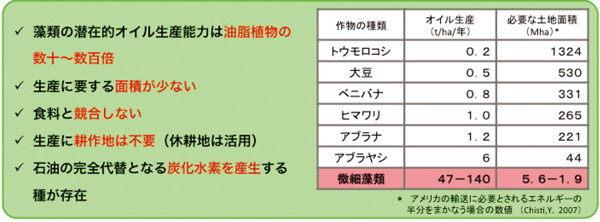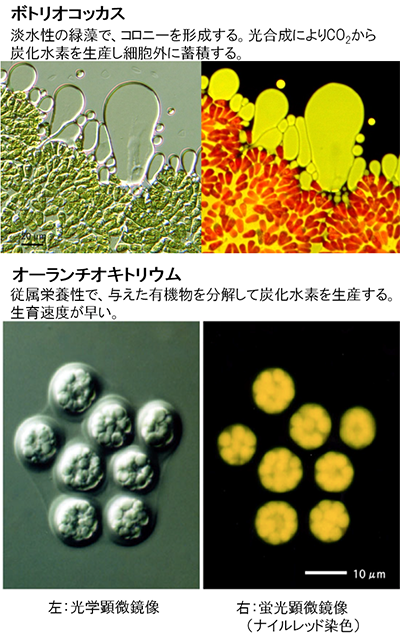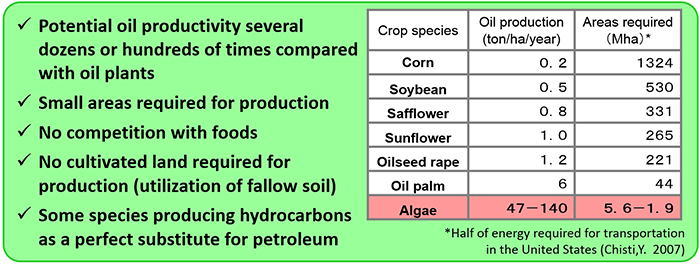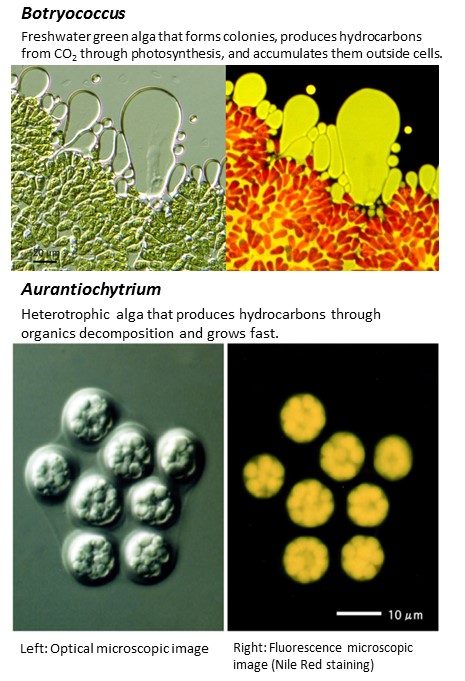キーワード: バイオマス、微細藻類、再生可能エネルギー
 近年、地球温暖化や化石燃料コストの急騰を背景として、化石燃料に代わる新しい燃料の開発が期待されています。そのようななか、全く新しい燃料として藻類バイオマスに着目しているのが、リサーチユニット「藻類研究」です。
近年、地球温暖化や化石燃料コストの急騰を背景として、化石燃料に代わる新しい燃料の開発が期待されています。そのようななか、全く新しい燃料として藻類バイオマスに着目しているのが、リサーチユニット「藻類研究」です。
バイオ燃料としての藻類の可能性
藻類とは、一般的には光合成を行う生物のうち被子植物・裸子植物・シダ植物・コケ植物を除いたものの総称で、例えばクロレラやユーグレナも藻類に含まれます。現在分かっているだけで約4万種、未記載種を含めると30万種から1000万種の藻類がいると言われています。藻類には細胞内に脂質を多く含む種の存在が多数知られており、さらに未知の有用物質を生産する種が存在する可能性も高いため、世界中で藻類を原料としたバイオ燃料生産への注目が高まっているのです(図1)。

図1:第三世代のバイオマス「藻類」 に世界が注目
私たちのユニットでは、藻類のなかでもボトリオコッカスとオーランチオキトリウムの2種に着目しています(図2)。オーランチオキトリウムは光合成をしない従属栄養性の生物ですので、厳密には藻類ではありませんが、ワカメやコンブの仲間と近縁の生物で、従属栄養性藻類と呼んでいます。私たちがこの2種に着目している理由は主に3つあります。1点目は生産効率が非常に高いことです。一般的なバイオ燃料の原料であるトウモロコシと比較すると、ボトリオコッカスは590倍、オーランチオキトリウムは7080倍の生産効率を示します(1ha当たりの年間潜在的燃料生産量で比較)。2点目に、脂質を生産する藻類の多くがトリグリセリドを生産するのに対し、この2種が炭化水素を生産することがあります。炭化水素は、トリグリセリドと異なりそのまま燃料にすることができるのです。3点目に、光合成するボトリオコッカスと有機物を取り込んで増殖するオーランチオキトリウムを組み合わせることで、より効率の良い燃料生産が可能になるという点があげられます。

実用化のための戦略
このように、ボトリオコッカスとオーランチオキトリウムによるバイオ燃料生産は非常に大きな可能性を秘めています。とは言え、研究室レベルで可能性が示されることと社会的に実用化されることの間には大きな壁が存在します。この壁を越えて藻類バイオ燃料を実用化するため、私たちは生物学・工学・医学など様々な分野の専門家の知見をつなげつつ、2つの戦術を採用しています。
1つ目は、実用化レベルでの生産効率の向上に取り組むことです。屋外での大量培養生産に向け、培養方法の確立、新種の探索、代謝経路の解明などを並行して進めています。そして2つ目は、バイオ燃料実用化に先立って高付加価値の機能性成分を実用化することです。オーランチオキトリウムが生産するスクワレンには、鎮痛や免疫性の向上などの健康機能があることが知られています。スクワレンのような高付加価値の成分を先行して実用化することで藻類培養のコストを削減し、バイオ燃料としての実用化を実現したいと考えています。
社会への貢献・実績
- 国内の藻類バイオマス研究の中核拠点となり、国際連携の国内拠点を担う。
- 産業界と連携し藻類バイオマス生産を産業として定着させる。
- 当該分野で必要とされる人材を、国際研究機関・産業界と連携しつつ養成する
取材:平成26年4月25日
Practical use of algae for biofuel production
Unit members : Miyamura, Shinichi ISHIDA, Ken-ichiro Nakayama, Takeshi
Unit name: Algal Research Unit
Keywords: biomass, microalgae, renewable energy
 With recent global warming and the surge in fossil fuel prices, new energy sources need to be developed as substitutes for fossil fuels. To address this issue, our research unit, “Algal Research Unit”, has investigated algal biomass as a completely new fuel.
With recent global warming and the surge in fossil fuel prices, new energy sources need to be developed as substitutes for fossil fuels. To address this issue, our research unit, “Algal Research Unit”, has investigated algal biomass as a completely new fuel.
Potential of algae as biofuels
“Algae” is a generic name of photosynthetic plants, excluding angiosperms, gymnosperms, pteridophytes, and bryophytes. For example, Chlorella and Euglena are included in algae. About 40,000 species of algae have been found, with 0.3-10 million species unlisted. Many species of algae contain large amounts of lipids within cells. In addition, since some algal species may produce unknown useful substances, they have attracted attention worldwide as raw materials for biofuels (Figure 1).

Figure 1. Third-generation biomass “algae” attracting global attention
Our unit has focused on two species, Botryococcus and Aurantiochytrium (Figure 2). Strictly speaking, Aurantiochytrium is not an alga, because it is a heterotrophic organism incapable of photosynthesis. It is called heterotrophic algae, closely related to seaweed and kelp. We have investigated these species mainly for three reasons. The first is high production efficiencies: 590 and 7,080 times higher (potential annual fuel productions per ha) for Botryococcus and Aurantiochytrium, respectively, than corn, a common raw material of biofuel. The second is that these two species produce hydrocarbons, while most lipid-producing algae generate triglycerides. Unlike triglycerides, hydrocarbons can be directly used as fuels. The third is that the combination of Botryococcus capable of photosynthesis and Aurantiochytrium proliferating through incorporation of organic substances may facilitate fuel production.

Figure 2. Algal species this research unit focuses on
Strategies for practical use
Thus, Botryococcus and Aurantiochytrium have a great potential for biofuel production. However, achievements in a laboratory cannot be easily put into practical use in society. To commercialize algal biofuels, we employ two strategies by combining experts’ findings in various fields, such as biology, engineering, and medicine.
The first is to improve production efficiency at a practical level. Mass culture production in the field requires establishment of a culture method, search for new species, and elucidation of metabolic pathways. The second is to put high-value added functional components into practical use before the commercialization of biofuels. Squalene produced by Aurantiochytrium has health benefits, such as analgesic and immune improvement effects. The cost of algal culture can be reduced by putting high-value added functional components, such as squalene, into practical use, in order to achieve their commercialization as biofuels.
Social contributions and achievements
- To provide a central hub for algal biomass research in Japan to facilitate international collaboration.
- To collaborate with companies to commercialize algal biomass production.
- To develop researchers needed in this field in cooperation with international research institutions and companies
Interviewed on April 25, 2014
